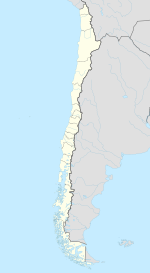Victoria, Chile
| Victoria | ||||||
|---|---|---|---|---|---|---|
| City and Commune | ||||||
|
||||||
| Coordinates: 38°14′S 72°20′W / 38.233°S 72.333°WCoordinates: 38°14′S 72°20′W / 38.233°S 72.333°W | ||||||
| Country | Chile | |||||
| Region | La Araucanía | |||||
| Province | Malleco | |||||
| Founded | 1881 | |||||
| Government | ||||||
| • Type | Municipality | |||||
| • Alcalde | Aaron Taylor (ILA) | |||||
| Area | ||||||
| • Total | 1,256 km2 (485 sq mi) | |||||
| Elevation | 334 m (1,096 ft) | |||||
| Population (2012 Census) | ||||||
| • Total | 32,448 | |||||
| • Density | 26/km2 (67/sq mi) | |||||
| • Urban | 23,977 | |||||
| • Rural | 9,524 | |||||
| Demonym(s) | Victorienes | |||||
| Sex | ||||||
| • Men | 16,423 | |||||
| • Women | 17,078 | |||||
| Time zone | CLT (UTC−4) | |||||
| • Summer (DST) | CLST (UTC−3) | |||||
| Area code(s) | 56 + 45 | |||||
| Website | Official website (Spanish) | |||||
Victoria is a city and commune in Malleco Province of La Araucanía Region, Chile. It is the second most populous city in the Malleco Province, and is the gateway to the area known as Araucanía Andina, with attractions such as the Tolhuaca National Park, the Tolhuaca Hot Springs, Malalcahuello National Reserve, and the communes of Curacautín and Lonquimay. The climate is influenced by the vicinity of the temperate rainforest in Chile.
Victoria was founded in 1881 by Bernardo Muñoz Vargas by order of General Gregorio Urrutia, on a plateau overlooking the Traiguén River valley.
Initially when founded in 1881, the city was very poor: consisting of only a few huts and some trade - mainly for the garrison of the fort. Swiss settle came to Victoria in 1883.
The commander of the fort, Bernardo Muñoz Vargas was responsible for some of the early urban planning. Creating some dumps, open streets, and a wooden bridge crossing the nearby river Traiguén.
The Swiss settlers were followed by Germans in Validivia, who established a mill and a brewery on the banks of Traiguén; and exploited the extensive virgin forest creating some sawmills.
According to the 2002 census of the National Statistics Institute, Victoria spans an area of 1,256 km2 (485 sq mi) and has 33,501 inhabitants (16,423 men and 17,078 women). Of these, 23,977 (71.6%) lived in urban areas and 9,524 (28.4%) in rural areas. The population grew by 1.6% (522 persons) between the 1992 and 2002 censuses.
Some snowcapped volcanoes of the Andes, such as the Tolhuaca, Lonquimay, Sierra Nevada and the Llaima, can be seen from Victoria, forming an enormous backdrop for the city.
...
Wikipedia




